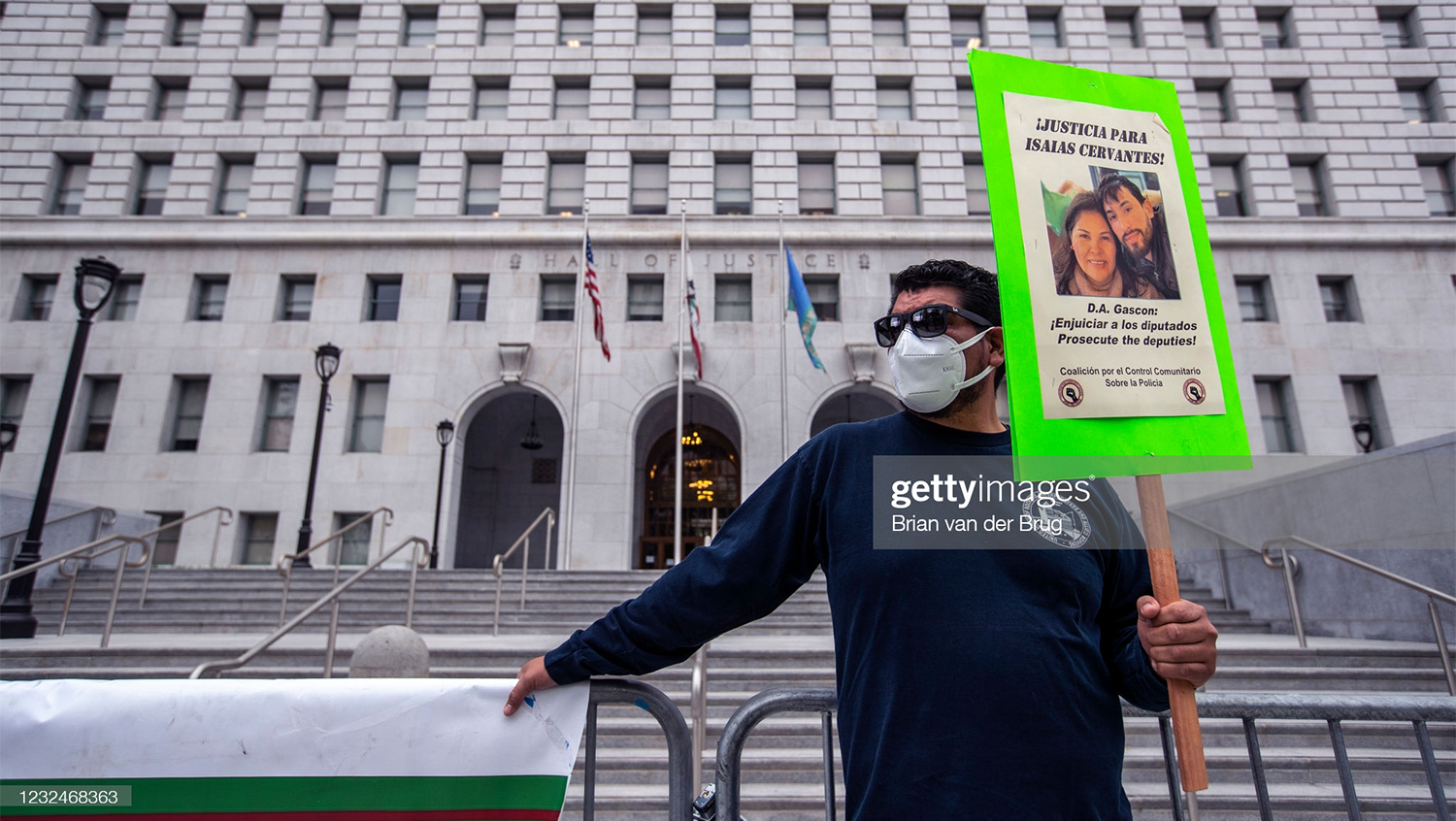It's Vital to Increase Police Understanding of Autism Spectrum Disorders
May 18, 2021

Brian van der Brug, Getty Images
Healthcare-informed training for police and security officers can increase recognition of autistic behaviors and help avoid misinterpretation and escalation.
Well before last summer’s groundswell of racial justice and anti-police-violence protests, Audrey Christiansen, MD, was thinking about the potential dangers of law enforcement encounters with people with autism spectrum disorder. Christiansen is a developmental and behavioral pediatrician at Boston Medical Center who specializes in children with developmental disabilities, particularly autism spectrum disorder (ASD). She is the lead author on two recently published studies: one in the Journal of Autism and Developmental Disorders examining police understanding of ASD and another in the Journal of Developmental & Behavioral Pediatrics on developing an ASD training program for hospital security personnel.
In the police study, officers with some training in or personal knowledge of ASD showed higher levels of comfort and were more likely to correctly identify clear signs of ASD in sample vignettes. However, few officers, regardless of prior training and experience, successfully recognized more subtle ASD signs that could be misinterpreted as “suspicious” behavior. Individuals with developmental disabilities, such as autism spectrum disorder, are 7 times more likely to come in contact with police than those without disabilities. So, the study highlights the need for improved police ability to recognize ASD behaviors and respond appropriately to reduce the chance of escalation.
Just in March, a Los Angeles sheriff’s deputy shot and paralyzed Isaias Cervantes, a 25-year-old man with ASD who is also hard of hearing. Reportedly, Cervantes’ sister called 911 to request help getting her brother to the hospital. The incident made headlines and sparked protests about the responders’ escalation—particularly because it appeared the deputies did not call the Sheriff’s Department’s Metal Evaluation Team, which includes a licensed mental health clinician, despite reportedly being aware of Isaias’ ASD and mental health diagnoses.
Christiansen spoke with HealthCity about the risks of police misinterpretation of ASD behaviors, what police and security officers need to know about autism, and how healthcare providers can help.
HealthCity: What spurred you to study police officers’ experience and comfort level with autism spectrum disorders?
Audrey Christiansen, MD: During my pediatric residency in Cleveland, Ohio, a teenager age 16 or 17 was brought into the emergency room by police officers. He had autism. He had been at home with his family and he got upset, it escalated, and he was a little bit aggressive. He was a tall kid, and non-verbal, so he didn’t have any language. He spent the next several hours of my shift sitting in a room watching cartoons. I saw that this kid who needed to be de-escalated ended up being a very sweet kid—yet he was brought in by six police officers. It just felt so overwhelmingly excessive.
There was a mobile crisis team you could call, similar to the BEST [Boston Emergency Services Team] program we have here [at Boston Medical Center] that can help de-escalate a crisis. But as things got really bad, often they would say, “You need to call 911.” And when you call 911, it’s the police that end up coming.
It was right after the Tamir Rice incident, so there was a spotlight on police brutality and police reform. And shortly thereafter, another incident occurred in Florida with a young man with ASD and his caregiver, and the police shot the caregiver. It just really got me thinking, if we’re expecting police officers to come into these situations with kids with developmental disabilities, what do they bring to the table when they show up at the scene?
HC: What do law enforcement officers not know about autism spectrum disorder, and what effects of that do health providers see or worry about?
AC: Both police and security officers are taught that eye contact is a really telling nonverbal cue—if somebody is not making eye contact with you, that’s suspicious. But one of the core aspects of autism is persistent deficits in social communication. Most people with autism don’t make eye contact regularly and consistently, and that could lead to them being more suspicious-looking.
Individuals with autism, especially older ones who perhaps are verbal and out in the community, could be misperceived. They could get arrested for suspicious behavior. So that is a worry. Especially with the current climate of policing in this country, I do worry about someone getting shot or hurt who appears aggressive but is really just trying to communicate something.
HC: What kind of training do police typically receive now about ASD?
AC: It’s variable in different police departments in cities across the country. In Cleveland at the time of this study, they had incorporated Crisis Intervention Team training, a voluntary one-week seminar. The autism training piece was a part of a larger developmental lecture that was about one hour, and the autism portion was one slide. The trainer asked, “Who knows what autism is? Have you ever met anyone with autism in your field of work?” and they just had a discussion.
There are also parent-led organizations that train police officers and other first responders in identifying autism. An example here in Massachusetts is ALEC, the Autism and Law Enforcement Education Coalition. Many of their trainers are police officers or first responders who have a child with autism. These programs have been pretty successful, though none of them have been studied, to my knowledge. But again, it’s all voluntary. The police department has to say, “We want to train our officers,” and seek these things out.
HC: What would proper police training on ASD look like? Did you gain some insights from developing and evaluating training for hospital security staff?
AC: Focusing on various de-escalation techniques, especially for people with mental illness, should be a part of police training throughout the country. Because even if we say, “Oh, you’re going to have access to a social worker,” the police officers are often still the first ones there. Just like they get CPR training, they should also get training in understanding of developmental disabilities, autism, and mental health. We’ve seen in some of the news stories recently, that maybe some de-escalation could have changed what happened.
With the hospital security staff, we first went through the basics—What is autism? What are developmental disabilities?—because I think that that’s important to understand. And then, What does autism look like?
Coming into the hospital can be particularly difficult for kids with autism. They have trouble with changes in their routine, and coming to the hospital is a massive change. They can have sensory sensitivities—with police encounters, it might be the multiple officers and the noise of the sirens, but in the hospital, lights and smells and textures can be particularly challenging. Even if they’re verbal, people with ASD often have difficulty explaining how they’re feeling. And so security officers need to understand, a kid having a tantrum in the hallway is trying to communicate something to us—that they’re frustrated, they’re overwhelmed, or they’re scared. We walked through case scenarios, what would you do in these various situations? And we focused a lot on other resources in the hospital they can call.
With police training, it would be similar. What does autism look like? I bring up eye contact a lot, something vastly different in people with autism. And pacing. A lot of people with autism have repetitive behaviors, like pacing, toe walking, spinning in circles—things that, again, could look suspicious.
And then we need to talk about things that could make situations worse, like siren noise or calling extra officers. Then, teaching police to know resources to call. If you get called for a kid with autism who’s upset and aggressive, what do you do? Where could you take them in your community?
One of the things we really stressed with security officers, and could stress with police, is that parents are experts on their kids. If this mom tells you that walking down by the creek is going to calm her kid down, listen. Because she knows that.
HC: You mentioned Tamir Rice and the importance of de-escalation. Is there a racial component to how police interact with people with autism?
AC: It definitely came to mind. At the time in Cleveland, I was practicing in a clinic near a primarily Black community. When I was talking to my mentors, one said, “I can imagine one of my Black patients with autism getting shot by the police,” because of some behavior. So that did come into the conversation, and I think it definitely plays into things, especially with the current climate.
HC: What role can healthcare practitioners and institutions have in improving law enforcement training and practices around ASD?
AC: I think we should definitely be more involved in trainings. Our autism program at BMC uses a parent panel as part of community trainings, because parents can speak to what it’s like to have a kid with autism and what kind of challenges they have. We can be connected there, and also as a resource to call. As developmental pediatricians we’re not always on call 24/7, but having some sort of resource, a provider or social worker or therapist, that families could call when things escalate up, so that they don’t necessarily have to call 911.
With my younger patients, I don’t routinely talk about police interactions. But if there’s a safety concern with kids that bolt and wander, I will suggest to parents, “Maybe go down to your local police station and introduce yourself and your child so that they know who your kid is, in case they find them when they’re on the street.”
We can also help families and children understand that it’s okay to tell people you have autism. I think it helps remove the stigma. Because there is a stigma about so many of these diagnoses in this country, and there shouldn’t be. It’s just who you are. You have a different way of navigating society, and navigating social situations for autism diagnosis, and it’s okay to tell people.
This interview has been edited and condensed.


